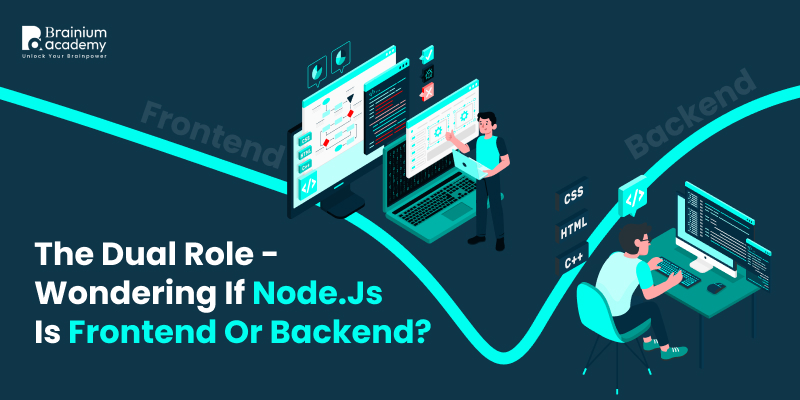
The Dual Role -Wondering If Node.Js Is Frontend Or Backend?
A quick online search will reveal that many consider Node.js as solely a back-end runtime environment. So, it is understandable that newbies to this technology question if Node.js is frontend or backend. It is true that in the past the tech was only seen as a tool for server-side development, but the fact that it is written in Javascript, opens up the possibility for seamless front-end operations as well. You will find Node.js in the tech stacks of many well-known companies. Netflix, Uber, NASA, LinkedIn and the list goes on and on.
Because of its non-blocking I/O, Node.js has an event-driven, asynchronous communication model. This ability to process standalone events makes it possible to build responsive data-intensive applications which can be scaled up or down as needed. A rich module library and an active and enthusiastic community indicate that it will continue to be the go-to choice for back-end and front-end developers alike.
What is Node.js?
Node.js is an open-source runtime environment that enables developers to code in JavaScript and run it outside of a web browser. The cross-platform tech allows you to seamlessly write CLI tools and build server-side scripts. Developers are able to create and personalize the content of a web page in real-time, while it’s being prepared on the server, before it is sent to the user’s web browser.
Heard of the V8 JavaScript engine? It is the powerful technology that powers Google’s Chrome browser and it is also used to run Node.js. A lot of web applications with heavy input/output tasks enjoy optimized throughput and scalability in Node.js. It works best for microservices, APIs and real-time web apps. Using JavaScript, Node.js enables client-side and server-side rendering which is why it is the ideal option for full-stack development.
The Main Node.js Features You Need To Know
Asynchronous and Event-Driven Architecture
Node.js is based on non-blocking I/O and event-driven approach, so you can expect it to be super light. Basically, its architecture has the capacity to concurrently manage a host of connections. It is designed to process many requests without waiting for the page to refresh. Stock trading, online gaming and chat applications that involve rapid, real-time interactions will benefit from this event-driven feature.
Single Threaded
Through the event loop feature in Node.js, the runtime environment is able to process several concurrent operations, even though it is single threaded. This approach makes development much easier, as developers do not have to explicitly handle thread concurrency. When I/O-heavy tasks are executed on Node.js, the event loop successfully handles the operations.
Extensibility and Customization
Systems that remain static are bound to become outdated. Developers can easily add functionalities, fine-tune existing ones or integrate the technologies they need in Node.js as the environment is quite extensible. The customizations would not compromise the current operations of the system. The usage of Node.js is rising as an increasing number of businesses are realizing the importance of working with future-proof and flexible technology.
Built-in HTTP and HTTPS Modules
Web servers can be created in Node.js by means of its default HTTP and HTTPS modules. This way you would not have to rely on third-party software. In fact, you would be able to quickly set up a server without any configuration or extensive setup. The HTTP and HTTPS protocols provide you with the choicest features to build and manage high-performing servers.
Multiple Platform Compatibility
People will use a diverse range of operating systems and devices to access your application. So it only makes sense that web applications are interoperable. Since Node.js is a cross-platform environment, it is designed to adapt to various platforms, enabling friction-free user experience. Here, JavaScript being a universal language is used everywhere, enabling smooth sailing development.
NPM (Node Package Manager)
As package managers go, Node Package Manager is an essential tool for Node.js developers. They can locate, build, modify and share JavaScript code from this CLI tool that also serves as an online repository of over two million packages. It is the default or in-built registry of Node.js. More than the development process getting sped up, developers have access to ready-made solutions to a host of common problems.
Microservices Architecture
Microservices are specialized single-function modules that, while independently deployable, are still loosely tethered together. This makes it easier for different teams to work on independent services without compromising the integrity of the application. For instance, they can carry out modifications, add new features or execute updates without disrupting the overall workflow. Node.js is resource-efficient which is why most developers favor it to build microservices architectures.
Quick Data Streaming
Banking apps, stock price monitoring apps, video streaming apps and other apps that require real-time processing can benefit from advanced data streaming of Node.js. Files are simultaneously processed and uploaded as they are broken down into manageable chunks without attempting to read the entire file in memory at once.
Node.js Is Frontend Or Backend?
Developers get to use a unified language all throughout the stack. In Node.js. programming the front end and back end in JavaScript is possible without further expertise. Sharing a codebase means that developers will not have to put in double the effort. They can write modules and functions one time and use it multiple times wherever needed.
They don’t need to toggle between a bunch of languages and frameworks, but can work smoothly in both environments. The code thus developed tends to be clean and consistent. You get a cross-functional team using the same codebase able to fluidly work on both client and server side tasks, as required. They are also adept at debugging for front-end and back end.
When you have a runtime environment with an event-driven, non-blocking model, front-end features are refined through rapid iterations and continuous testing. Products reach the market much faster this way.
The microservices architecture in Node.js makes it suitable for modular back-end development. Because the application’s services are chopped up into smaller, self-contained chunks, the system can be maintained and scaled without disruptions to workflow.
Front-end tends to include elaborate build processes, for instance, bundling which involves packaging up JavaScript files into a single file, minification which eliminates superfluous characters and code comments to shrink the file size, and transpilation which is designed to make modern JavaScript code understandable to older browsers. With the required Node.js-based tools developers can tackle these tasks without much effort.
Node.js works seamlessly with JSON, a minimal and readable syntax for communication between the server and the client. RESTful APIs can be easily developed using Node.js taking advantage of its massive ecosystem of libraries and its potential to process several requests simultaneously.
Front-end tasks like website performance and SEO are enhanced because of server-side rendering (SSR) on Node.js. HTML templates on the server are converted into full-formed HTML pages, not a basic template, before being sent to the browser. It allows rapid page loads where content is displayed on the browser without any delay while JavaScript renders the page. The pre-rendered content is seamlessly indexed on Search, amplifying the web applications visibility and ranking in SERPs.
With its event-driven architecture, Node.js has everything that a real-time application would need. Payment gateway systems, transport booking systems, video streaming platforms and the like, can be built on Node.js as it can handle asynchronous tasks and process data in real-time. It doesn’t lag despite sorting out a host of tasks at the same time, providing a solution for every user request that comes in. On the front-end, you get interactive and dynamic UIs with the architecture to tackle real-time updates on the fly.
Can Node.js Be Used With Other Frameworks And Libraries?
Developers can use Node.js in conjunction with many different frameworks, deployment tools, databases and libraries. Here’s a look at some well-known pairings with Node.js.
When Node.js is paired with the framework Express.js for back end development, its scope opens up to include a wide range of features required to craft APIs and web applications. It serves as the middleware layer of Node.js, tackling all the programming tasks on the back-end, like session management, routing, processing HTTP requests and so forth. You can quickly set up server-side applications.
JavaScript frameworks and libraries including Angular, React, Vue.js are great options for Node.js front-end tasks. These technologies help to develop responsive and interactive UIs, leaving Node.js to look after the server-side tasks, keeping an open line of communication between both environments. Socket.IO is a JavaScript library that makes it possible for clients (such as web browsers) to communicate with servers in real time; this seamless integration with Node.js can be taken advantage of. Under the hood, Socket.IO uses WebSocket technology, but if a client or network does not support WebSockets, it will gracefully fallback to other transport mechanisms. This makes the tool perfect when there is a need to build applications which demand instant updates or collaboration features—for example chat systems, live streaming platforms or collaborative editing tools. Responsive and interactive web experiences are easily created by developers who use “Node.js” on the server side and “Socket.IO” for real-time communication.
Another good combination is Node.js and GraphQL which is a query language for APIs together with a runtime for executing those queries. With its ability to allow client requests only specific data items they require, this makes it more efficient than traditional RESTful API designs where large amounts of information may be transferred over the network. Node.js leverages its strengths in handling asynchronous operations and effectively managing data sources while GraphQL simplifies server-side data fetching and manipulation. Such a mix proves especially helpful when working on projects with complicated data needs or having many different types of clients (for instance web browsers, mobile devices & IoT gadgets) which are supposed to connect with similar API endpoints but with different usage patterns.
What is more, thanks to various ORM (Object-Relational Mapping) tools and libraries within the Node.js ecosystem, one can also use Node.js alongside databases such as MySQL, MongoDB or PostgreSQL among others. These tools make it easier to interact with databases by providing simplified interfaces for commonly performed operations as well as helping applications manage their data with ease.
Wrapping Up
Aspire developers need to learn Node.js to use its full potential, in both the back-end environment as well as the front-end. This multifaceted scope is why Node.js is often selected for full-stack development projects, allowing developers to craft high-performing cross-platform servers, web applications, CLI tools and more.
